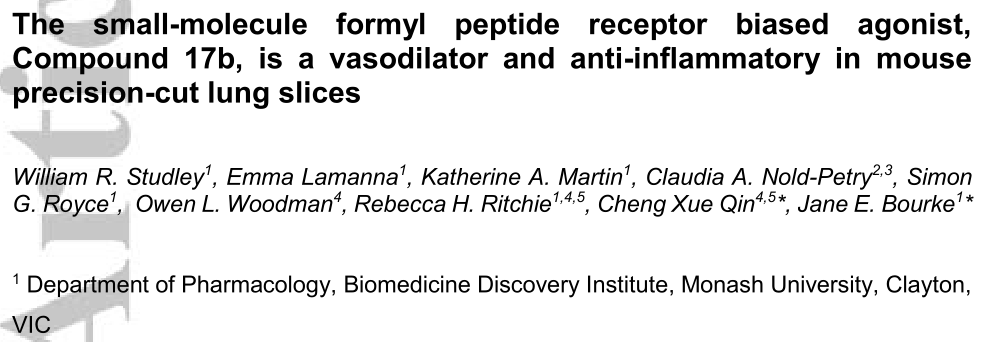预约演示
更新于:2025-05-07
FPR1 x FPR2
更新于:2025-05-07
关联
1
项与 FPR1 x FPR2 相关的药物作用机制 FPR1 antagonists [+1] |
非在研适应症- |
最高研发阶段临床前 |
首次获批国家/地区- |
首次获批日期1800-01-20 |
100 项与 FPR1 x FPR2 相关的临床结果
登录后查看更多信息
100 项与 FPR1 x FPR2 相关的转化医学
登录后查看更多信息
0 项与 FPR1 x FPR2 相关的专利(医药)
登录后查看更多信息
226
项与 FPR1 x FPR2 相关的文献(医药)2025-05-01·Molecular Carcinogenesis
Potential Crosstalk Between ANXA1+ Epithelial Cells and FABP4+ TAM Cells of Ferroptosis‐Related Molecular Clusters Promotes an Immunosuppressive Microenvironment in Non‐Small Cell Lung Cancer
Article
作者: Liu, Zhiqiang ; Mao, Shengqiang ; Zhang, Li ; yang, Ying ; Li, Qingyan
2025-01-01·Pharmacology & Therapeutics
Pro-resolving lipid mediators and therapeutic innovations in resolution of inflammation
Review
作者: Chen, Jianmin ; Peh, Hong Yong
2024-11-01·Journal of Allergy and Clinical Immunology: Global
Increased expression of formyl peptide receptor-1 by basophils from patients with mastocytosis
Article
作者: Li, Jenny Min ; Metcalfe, Dean D. ; Komarow, Hirsh ; Olivera, Ana ; Yin, Yuzhi ; Frischmeyer-Guerrerio, Pamela A. ; Carter, Melody C.
6
项与 FPR1 x FPR2 相关的新闻(医药)2025-03-14
·学术经纬
▎药明康德内容团队编辑
神经酰胺作为鞘磷脂代谢通路的核心分子,其研究历史可追溯至19世纪末。1884年,德国化学家Johann Thudichum首次从脑组织中分离出鞘脂类物质,并命名为"sphingolipids"。在后续的研究中,科学家已经发现神经酰胺具有丰富的结构多样性,并在哺乳动物体内已鉴定出300多种不同类型。其分子结构主要由两条链构成:一条为脂肪酸链,另一条为鞘氨醇链。脂肪酸链的特异性取决于其碳链长度和不饱和双键的位置;鞘氨醇链则包括二氢鞘氨醇(DS)、6-羟基鞘氨醇(H)等多种类型。
此外,神经酰胺还可通过鞘脂基团的修饰(如磷酸化、葡萄糖基化、半乳糖基化等)进一步增加其结构多样性,从而赋予其不同的生物学功能。研究表明,神经酰胺具有双重生物学效应:在生理浓度范围内,它对皮肤具有保湿,抗衰老的有益作用。然而,当其在血液中异常积累时,则可能引发一系列病理改变。
临床研究证实,神经酰胺水平升高与多种代谢性疾病密切相关,包括2型糖尿病、肥胖症、非酒精性脂肪肝及动脉粥样硬化等。2023年,《科学》杂志的一篇专题文章指出神经酰胺可能比胆固醇更具心血管疾病预测价值,这一观点获得了学界广泛关注。
图片来源:123RF
姜长涛课题组前期研究发现,神经酰胺作为器官间介质具有多重病理作用:肠上皮释放的神经酰胺抑制米色脂肪产热、加剧肝脂肪变性和血管炎症;脂肪源性神经酰胺则加重动脉粥样硬化,但其作用机制仍存在重大知识缺口。神经酰胺在器官间运输的机制以及外源神经酰胺如何调节靶细胞的信号传导也还不清楚。特别是近年发现的快速调控现象(如数分钟内影响葡萄糖转运)提示可能存在尚未明确的膜受体介导机制。然而,神经酰胺特异性膜受体的鉴定及其信号转导机制解析,仍是该领域亟待破解的核心科学难题。
有趣的是,神经酰胺分子的两部分:鞘氨醇骨架和可变链长的脂肪酸链,均具有独立激活G蛋白偶联受体(GPCR)的能力,从而介导不同的生物学功能。在鞘氨醇信号通路中,鞘氨醇-1-磷酸(S1P)作用于S1P受体家族(S1PR1-5),在淋巴细胞迁移、血管稳态维持等生理过程中发挥重要调控作用,基于这一机制研发的靶向药物已在多发性硬化症等自身免疫性疾病的临床治疗中取得显著成效。
孙金鹏教授团队和艾丁教授、朱毅教授团队曾合作发现了17,18-EEQ通过S1PR1偏向性激活Gq信号,调控动脉粥样硬化的进展。神经酰胺的另一部分脂肪酸的结构特征(包括碳链长度、双键构型及不饱和键位置等)也被证实是GPCR信号识别的重要决定因素。
此外,孙金鹏教授和于晓教授团队还联合发现胰岛内源性脂质-油酸(OA)和亚油酸 (LA)两种长链脂肪酸(LCFA)激活脂肪酸受体GPR120对胰岛稳态具有调控作用,揭示了鱼油受体GPR120识别脂肪酸中单双键并引起不同信号转导的机制。进一步研究表明,神经酰胺可抑制细胞内的cAMP积累(这一现象通常与Gi/o蛋白偶联受体的激活相关),一个重要科学问题随之浮现:是否存在特定的GPCR亚型能够直接识别完整神经酰胺分子,并通过调控第二信使动态平衡来介导关键的细胞应答?
2025年3月14日,山东大学基础医学院孙金鹏教授团队,联合北京大学医学部基础医学院姜长涛教授和孔炜教授团队,山东大学于晓教授团队,在《科学》(Science) 在线发表了研究论文, 鉴定出脂肪细胞中的神经酰胺膜受体FPR2,系统阐明了神经酰胺-FPR2信号轴调控脂肪产热的作用机制,揭示了FPR2特异性识别神经酰胺的分子机制。这项突破性工作不仅为深入理解神经酰胺的生物学功能提供了全新视角,更为代谢性疾病的靶向治疗开辟了新的研究方向。
研究团队在体外实验中发现,特定类型的C16:0神经酰胺短时间刺激(15分钟)会降低棕色脂肪组织、米色脂肪组织及其相应细胞内的cAMP含量,提示可能存在一种Gi偶联的GPCR受体介导神经酰胺对脂肪组织的快速调控作用。随后,团队利用GloSensor-cAMP方法筛选棕色脂肪中表达量前60位的GPCR,发现C16:0神经酰胺可激活FPR2受体导致cAMP含量下降。通过BRET-G蛋白解离实验进一步验证,发现C16:0神经酰胺通过激活FPR2的Gi1和Gi2信号通路发挥作用,最终确定FPR2是脂肪细胞中Gi偶联的神经酰胺受体。
▲研究示意图(图片来源:研究团队提供)
为了明确FPR2是否介导C16:0神经酰胺对脂肪产热的抑制作用,研究团队构建了冷刺激产热模型。发现在Ucp1-Cre+/-Fpr2fl/fl和Adipoq-Cre+/-Fpr2fl/fl 两种敲除小鼠中,或通过使用Fpr2的拮抗剂WRTW4干预后,在不影响小鼠饮食和运动的情况下,均显著减轻神经酰胺对脂肪产热的抑制作用,小鼠表现为能量代谢和氧消耗量显著增加、体温升高,且脂肪组织中产热基因表达及UCP1蛋白水平上调。上述结果表明,在生理冷刺激条件下,C16:0神经酰胺通过激活脂肪细胞的FPR2受体抑制产热。
▲C16:0神经酰胺通过FPR2抑制冷暴露诱导的产热(图片来源:研究团队提供)
最后,研究人员解析了神经酰胺-FPR2-Gi复合物的三维结构,发现神经酰胺的鞘链深埋于FPR2正构结合口袋底部,而脂肪酸链则在口袋上方呈现特征性折叠构象(“p”或“S”形)。这种独特的结合模式阐释了FPR2对神经酰胺的选择性识别机制——过长的脂肪酸链和含双键脂肪酸链的神经酰胺会因口袋可容纳空间不足导致结合能显著降低。基于此发现,研究人员通过系统性的定点突变策略,成功将FPR1/FPR3(同家族非神经酰胺敏感受体)改造为神经酰胺响应型受体。这不仅验证了关键功能基序的分子逻辑,更为GPCR家族的功能重编程提供了范式参考。
▲FPR2识别不同长链神经酰胺的分子机制(图片来源:研究团队提供)
综上所述,这项研究鉴定了FPR2为脂肪细胞中的神经酰胺膜受体,阐明其通过Gi-cAMP信号级联抑制脂肪组织产热的功能机制,并解析了FPR2选择性识别不同链长神经酰胺的结构密码。值得关注的是,该团队在《自然》发表的姊妹研究中,进一步发现心血管系统存在CYSLTR2和P2RY6神经酰胺新型受体,揭示神经酰胺信号网络具有显著的组织异质性与功能复杂性。这一系列研究构建了神经酰胺信号转导的分子拓扑图谱,更颠覆了脂质分子仅通过扩散作用调控代谢的传统认知。基于受体结构开发的变构调节剂与脂质纳米靶向载药系统,将为肥胖、糖尿病等代谢综合征提供了精准干预策略。
山东大学口腔医学院博士后林慧,山东大学基础医学院博士生马传顺,北京大学基础医学院博士生蔡葵,山东大学高等医学研究院研究员郭璐璐,北京大学基础医学院博士后王雪梅、山东大学基础医学院博士生吕琳、张超和北京大学基础医学院博士后林骏为本文的共同第一作者;北京大学基础医学院/山东大学孙金鹏教授,北京大学基础医学院姜长涛教授、孔炜教授,山东大学基础医学院于晓教授为本文的通讯作者。此外,山东大学基础医学院易凡教授、药学院秦承雪教授也为该工作提供了重要帮助。
孙金鹏教授团队长期致力于膜受体G蛋白偶联受体的相关研究,聚焦于GPCR的配体发现、药物靶点确证、功能研究和小分子确证,取得了系列原创性研究成果,在破解“卡脖子”技术难题、推动科研高质量发展方面取得一系列重要突破。以通讯作者在Nature(9篇),Science(2篇),Cell (4篇)等国际期刊发表多篇文章。揭示了粘附类受体(aGPCRs)是识别类固醇激素的GPCR亚家族(Nature 2021, 589: 620-626;Nat Chem Biol 2022, 18(11):1196-1203;PNAS 2022, 119(15):e2117004119);揭示了痒觉受体的内源性配体和独特的激活模式(Nature. 2021;600(7887):164-169);阐释了黏附类受体对力的感知机制并发展了多肽激动剂和拮抗剂(Nature. 2022a 604(7907):771-778; Nature. 2022b 604(7907):763-770); 解析了嗅觉受体对气味的感知机制( Nature. 2023 Jun;618(7963):193-200)。研究成果入选2023年中国十大科技进展。
姜长涛教授团队从事肠道共生菌与代谢性疾病的研究。在发现菌群—宿主互作的关键信使—胆汁酸的全新菌源修饰类型及生物合成通路,是脂肪性肝炎防治的新策略;以及首次发现了降解尼古丁的肠道共生菌及其在脂肪性肝炎发病中的关键保护作用等方面取得重要进展。近5年在Cell、Science、Nature、Nature Microbiology、Cell Metabolism等高水平期刊发表多篇重要文章。
孔炜教授团队致力于血管微环境与重大心血管疾病的相关研究,尤其在血管重塑、炎症与代谢调控等领域取得了一系列重要成果。团队依托北京大学医学部的优质科研平台,结合多学科交叉优势,聚焦于血管疾病的分子机制与创新治疗策略。近几年,孔炜教授以通讯作者在Nature、Circulation、Blood、Cell research、Circulation Research等期刊发表多篇高水平论文。
原始论文:
[1] Lin, H., et al. Metabolic signaling of ceramides through the FPR2 receptor inhibits adipocyte thermogenesis. Science (2025). DOI: 10.1126/science.ado4188
本文来自药明康德内容微信团队,欢迎转发到朋友圈,谢绝转载到其他平台。如有开设白名单需求,请在“学术经纬”公众号主页回复“转载”获取转载须知。其他合作需求,请联系wuxi_media@wuxiapptec.com。
免责声明:药明康德内容团队专注介绍全球生物医药健康研究进展。本文仅作信息交流之目的,文中观点不代表药明康德立场,亦不代表药明康德支持或反对文中观点。本文也不是治疗方案推荐。如需获得治疗方案指导,请前往正规医院就诊。
更多推荐
点个“在看”再走吧
2025-03-14
·生物世界
撰文丨王聪
编辑丨王多鱼
排版丨水成文
神经酰胺(Ceramides)在人类健康和疾病中发挥着核心作用,但其作为全身系统性信号分子的作用,目前仍知之甚少。
2025 年 3 月 13 日,山东大学基础医学院孙金鹏教授团队联合北京大学医学部基础医学院姜长涛教授和孔炜教授团队及山东大学于晓教授团队,在国际顶尖学术期刊 Science 上发表了题为:Metabolic signaling of ceramides through the FPR2 receptor inhibits adipocyte thermogenesis 的研究论文,这已是孙金鹏教授作为通讯作者发表的第 15 篇 CNS 论文。
该研究鉴定出了脂肪细胞中的神经酰胺膜受体——FPR2,系统阐明了神经酰胺-FPR2信号轴调控脂肪产热的作用机制,揭示了FPR2特异性识别神经酰胺的分子机制。这项工作不仅为深入理解神经酰胺的生物学功能提供了全新视角,更为代谢性疾病的靶向治疗开辟了新的研究方向。
在这项最新研究中,研究团队确定了 FPR2 是一种膜受体,能够特异性结合长链神经酰胺(C14-C20)。
在棕色脂肪和米色脂肪细胞中,C16:0 神经酰胺与 FPR2 结合通过 Gi - 环磷酸腺苷信号通路(Gi-cAMP)抑制产热,而在缺乏 FPR2 的情况下这种效应会被逆转。
研究团队进一步解析了 FPR2 与结合了 C16:0、C18:0 和 C20:0 神经酰胺的 Gi 三聚体复合物的冷冻电镜结构,其疏水尾部深深嵌入正构配体口袋中,该口袋的可塑性有限。对紧密相关的受体(如 FPR1 或 FPR3)中神经酰胺结合基序的修改,可将其从无活性的神经酰胺受体转变为有活性的神经酰胺受体。
总的来说,这项研究鉴定了 FPR2 为脂肪细胞中的神经酰胺膜受体,阐明其通过 Gi-cAMP 信号级联抑制脂肪组织产热的功能机制,为 FPR2 介导的脂肪细胞产热提供了结构基础,并解析了 FPR2 选择性识别不同链长神经酰胺的结构密码。
此外,2025 年 3 月 6 日,北京大学医学部基础医学院、血管稳态与重构全国重点实验室孔炜教授团队联合北京大学医学部基础医学院/山东大学孙金鹏教授团队、北京大学医学部基础医学院姜长涛教授团队及中日友好医院心脏科郑金刚教授团队,在国际顶尖学术期刊 Nature 上发表了题为:Sensing ceramides by CYSLTR2 and P2RY6 to aggravate atherosclerosis 的研究论文。
该研究首次鉴定了神经酰胺的内源性受体——CYSLTR2 和 P2RY6,阐明了神经酰胺加重动脉粥样硬化的作用及分子机制,解析了神经酰胺-CYSLTR2 复合物结构,从而为动脉粥样硬化相关疾病带来了全新治疗靶点。
这些研究构建了神经酰胺信号转导的分子拓扑图谱,颠覆了脂质分子仅通过扩散作用调控代谢的传统认知。基于受体结构开发的变构调节剂与脂质纳米靶向载药系统,有望为肥胖、糖尿病等代谢综合征提供了精准干预策略。
山东大学孙金鹏教授团队长期致力于膜受体 G 蛋白偶联受体(GPCR)相关研究,聚焦于 GPCR 的配体发现、药物靶点确证、功能研究和小分子确证,取得了系列原创性研究成果,在破解“卡脖子”技术难题、推动科研高质量发展方面取得一系列重要突破;作为通讯作者发表了 15篇 CNS 论文,其中 Nature 9篇、Science 2篇、Cell 4篇,这些研究揭示了粘附类受体(aGPCR)是识别类固醇激素的 GPCR 亚家族;揭示了痒觉受体的内源性配体和独特的激活模式;阐释了黏附类受体对力的感知机制并发展了多肽激动剂和拮抗剂;解析了嗅觉受体对气味的感知机制等。
论文链接:
https://www.science.org/doi/10.1126/science.ado4188
https://www.nature.com/articles/s41586-025-08792-8
设置星标,不错过精彩推文
开放转载
欢迎转发到朋友圈和微信群
微信加群
为促进前沿研究的传播和交流,我们组建了多个专业交流群,长按下方二维码,即可添加小编微信进群,由于申请人数较多,添加微信时请备注:学校/专业/姓名,如果是PI/教授,还请注明。
点在看,传递你的品味
临床1期
2023-09-27
·生物谷
肺动脉高压(PAH)是一种罕见但致命的疾病,其特征是炎症、血管重构和血管收缩。目前的血管扩张剂治疗可以降低肺动脉压(PAP),但不能降低死亡率。
肺动脉高压(PAH)是一种罕见但致命的疾病,其特征是炎症、血管重构和血管收缩。目前的血管扩张剂治疗可以降低肺动脉压(PAP),但不能降低死亡率。G蛋白偶联的甲酰肽受体(FPR)介导血管扩张和炎症消退,这些作用可能有益于PAH。研究者利用小鼠精密肺切片(PCLS)研究了偏向于FPR的激动剂化合物17b(Cmpd17b)在肺血管中的扩张剂和抗炎作用。
图片来源:https://pubmed.ncbi.nlm.nih.gov/37696768/
近日,来自莫纳什大学的研究者们在Br J Pharmacol杂志上发表了题为“Flucloxacillin worsens while imipenem-cilastatin protects against vancomycin induced kidney injury in a translational rat model”的文章,该研究首次提供了靶向FPR的证据,使用一种有偏见的激动剂,同时靶向血管功能和炎症,支持基于FPR的药物治疗PAH的发展。
研究者使用8周龄雄性和雌性C57BL/6小鼠的PCLS,用5-羟色胺预收缩肺内动脉,以测定对FPR激动剂Cmpd17b和Cmpd43以及标准护理西地那非、伊洛前列素和利奥昔格特的浓度-反应曲线。
Cmpd17b介导的松弛作用于±fpr受体拮抗剂或药物抑制剂,以及经肿瘤坏死因子-α或内毒素处理的PCLS。测定经肿瘤坏死因子-α和内毒素处理后的PCLS±Cmpd17b细胞因子的释放。
Cmpd17b可引起浓度依赖性的血管扩张,其作用强度为iloprost>Cmpd17b=riociguat>Cmpd43=Sildenaven。Cmpd17b可被FPR1拮抗剂环孢素-H抑制,但不能被sGC、NOS或COX的抑制剂抑制。在炎症条件下,Cmpd17b的疗效和效力保持不变,而伊洛前列素和西地那非的效果较差。此外,Cmpd17b通过FPR2抑制PAH相关细胞因子的分泌。
血管扩张剂对FPR激动剂Cmpd17b和Cmpd43以及标准护理血管扩张剂西地那非、利奥昔古特和伊洛前列斯特的反应
图片来源:https://pubmed.ncbi.nlm.nih.gov/37696768/
对Cmpd17b的血管扩张,但不是标准护理血管扩张剂,在炎症条件下保持不变,并额外抑制PAH相关细胞因子的释放。本研究首次提供了靶向FPR的证据,使用一种有偏见的激动剂,同时靶向血管功能和炎症,支持基于FPR的药物治疗PAH的发展。(生物谷 Bioon.com)
参考文献
William R Studley et al. The small-molecule formyl peptide receptor biased agonist, Compound 17b, is a vasodilator and anti-inflammatory in mouse precision-cut lung slices. Br J Pharmacol. 2023 Sep 1. doi: 10.1111/bph.16231.

临床结果临床研究
分析
对领域进行一次全面的分析。
登录
或

生物医药百科问答
全新生物医药AI Agent 覆盖科研全链路,让突破性发现快人一步
立即开始免费试用!
智慧芽新药情报库是智慧芽专为生命科学人士构建的基于AI的创新药情报平台,助您全方位提升您的研发与决策效率。
立即开始数据试用!
智慧芽新药库数据也通过智慧芽数据服务平台,以API或者数据包形式对外开放,助您更加充分利用智慧芽新药情报信息。
生物序列数据库
生物药研发创新
免费使用
化学结构数据库
小分子化药研发创新
免费使用
